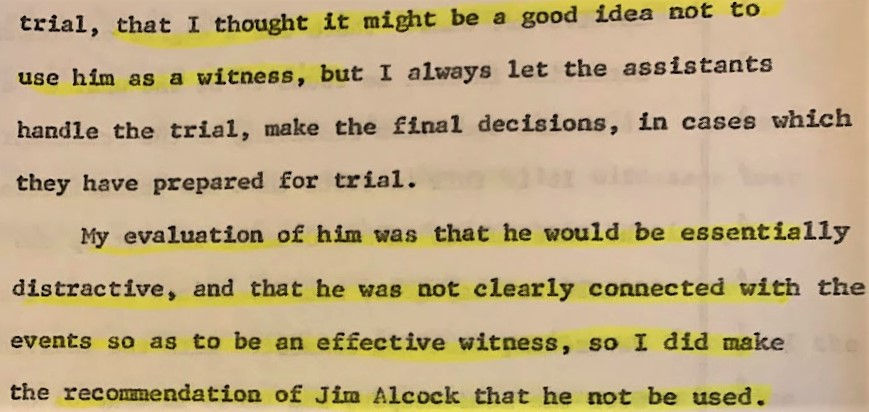In the lawsuit to stop Garrison's perjury charges, Judge Herbert Christenberry held three days of hearings in January of 1971. Jim Garrison, still the District Attorney, was forced to take the stand and was examined by Clay Shaw's attorneys - Edward Wegmann and Irvin Dymond. John Volz and William Alford were the lawyers for Garrison.
Here are some of the highlights of Garrison's testimony:
Right off the bat, Garrison is confused about how many times he asked Clay Shaw in for an interview. Shaw came in late December 1966, and then on March 1st when he was arrested). He's not even sure why he was a suspect.




Garrison doesn't even know how many times Perry Russo was hypnotized (it was three times).


Garrison is then shown a copy of Clay Shaw's indictment and then claimed that David Ferrie was alive when Clay was indicted.

This is all not true. Ferrie had died a week earlier, and while Garrison claimed at the time that he was considering indicting Ferrie, that was later contradicted by James Alcock, his second-in-command.
Garrison would not tell the court what witnesses he based the Shaw indictment on.



Judge Christenberry answered the question for Garrison - the only witness he had prior to the arrest of Clay Shaw was Perry Russo.
Shaw's lawyers then probed about the case against Clay Shaw, and they spring a trap. Garrison had charged Shaw with perjury for denying he knew David Ferrie and Lee Harvey Oswald. So, if Garrison admits that proving Shaw knew Oswald and Ferrie was an "essential and material" part of his case, then Shaw's acquittal would mean he could not be charged with perjury. And so, Garrison did not want to answer the question.



And, what about the witnesses who discussed the assassination in Dallas.


Garrison was then asked about witness Charles Spiesel:


I don't believe this for a second. There is no evidence that Garrison recommended Spiesel not be called as a witness.
Garrison is then questioned about Perry Russo's lie detector test. Edward O'Donnell interviewed Russo and tried to deliver a polygraph test on June 16, 1967. The readings were erratic and so the test was stopped. O'Donnell kept asking questions, and Russo admitted that perhaps Clay Shaw might not have been at the meeting at Ferrie's apartment.



Here is the O'Donnell report:


Garrison is then shown a copy of this report:


Garrison was then asked about witness Vernon Bundy.


So, the Court was forced to make a determination (which was correct) that they found Bundy after Shaw was arrested.
Garrison continued to be uncooperative.


Garrison was asked whether the perjury charges against Clay Shaw were unique:


The Judge then had a question for Garrison:

And, there was this revelation from Garrison in a discussion about his book, A Heritage of Stone:

This was news to everybody. But, Garrison had plans:


Garrison then turned emotional and waxed eloquently about how he cared for Clay Shaw.


That mood didn't last long:


And to end Garrison's testimony, the theater of the absurd!


You can read more about Boxley in my book, On The Trail of Delusion - Jim Garrison: The Great Accuser. Boxley was perhaps Garrison's favorite investigator because he fed back the same conspiracy theories. He was not a CIA agent - Harold Weisberg and Vincent Salandria convinced Garrison he was so that he could be fired.